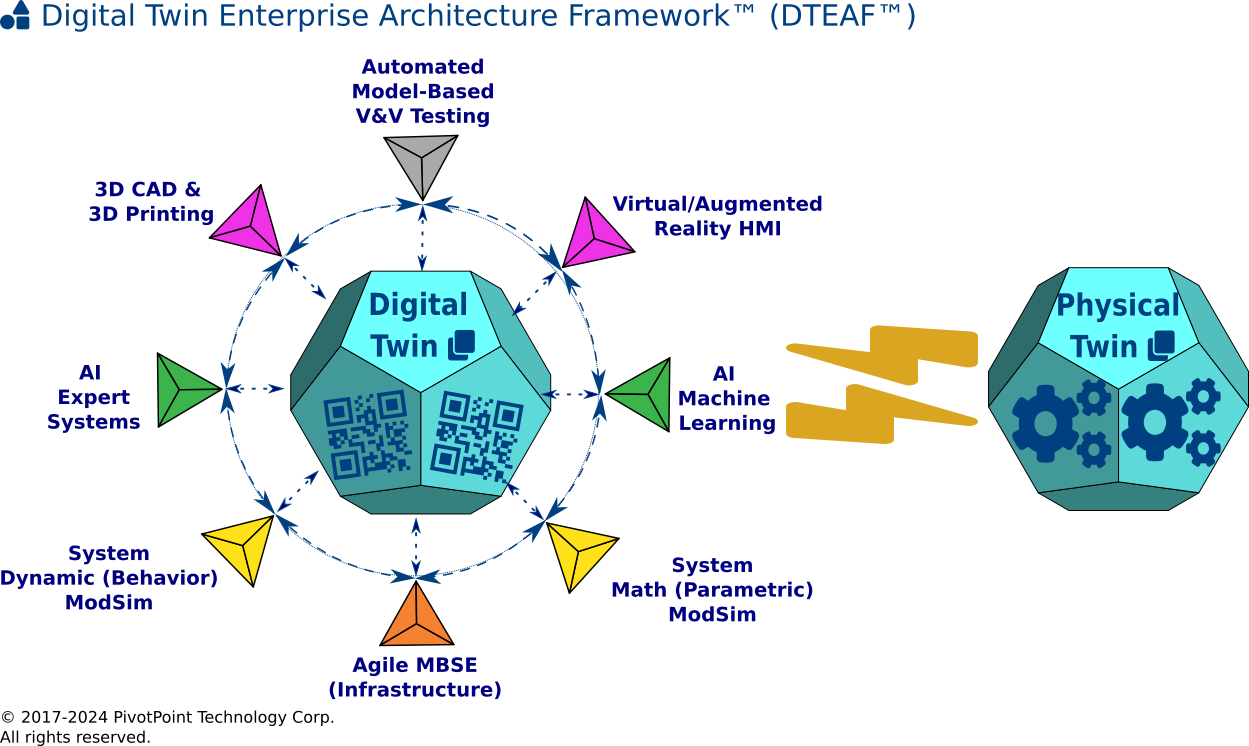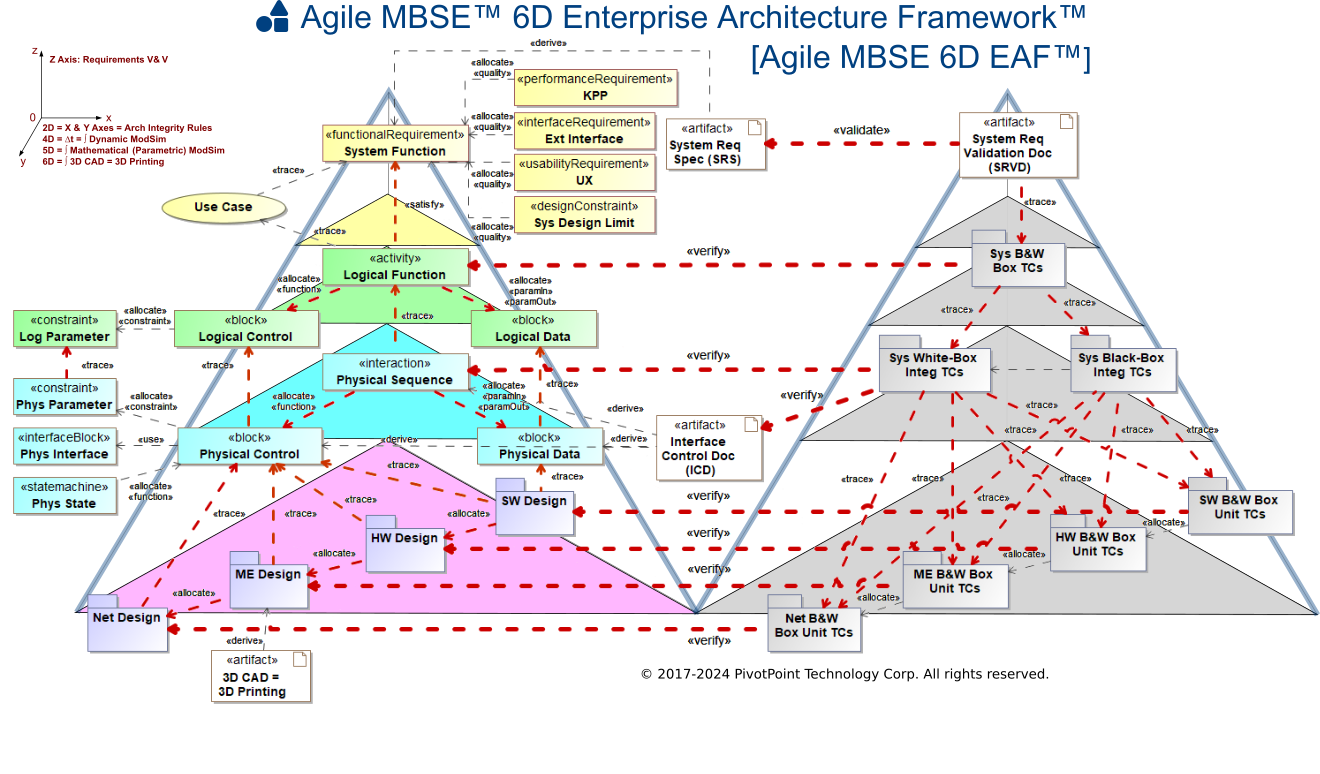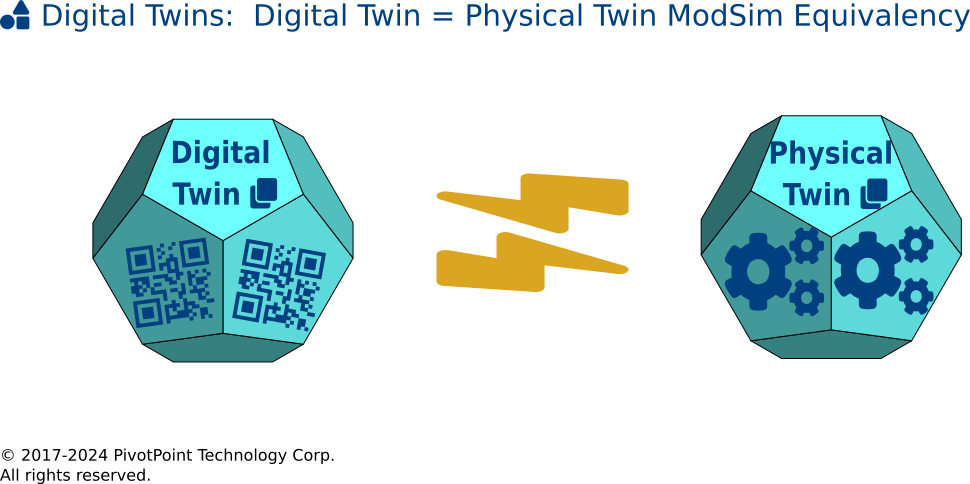PivotPoint FAQ: What is Model-Based Digital Engineering™ (MBDE™)?
What is Model-Based Digital Engineering™ (MBDE™)?
FAQ Variant(s): What is MBDE?
PivotPoint's mathematically-rigorous and project battle-tested Model-Based Digital Engineering™ (MBDE™) approach crystallizes the vague vision of the DoD's Digital Engineering Strategy [DoD 2018] and realizes the potential of fully simulatable and executable system-of-systems architectures, which are de facto "Digital Twins". PivotPoint's rigorous and pragmatic approach to Smart MBSE is based on over two decades of hands-on mission-critical project experience with a wide variety of clients (multitudes of US government forces and agencies and international Fortune 1000 companies) across a wide range of problem domains (mil/aero, automotive/trucking, telecom, robotic surgery, SoS chip design, etc.). For more information about PivotPoint and its visionary Founder & CTO, Cris Kobryn, see the About page.
Definition
Model-Based Digital Engineering™: MBDE™ is a holistic systems engineering approach to the architecture and design of complex systems-of-systems that synergistically fuses four complementary technologies to produce "Digital Twins" (simulatable and executable system-of-system architectures):
Enterprise Architecture Frameworks & ModSim Libraries Support for Project Fast Starts & Reuse
PivotPoint's Smart MBDE approach is enabled by rigorous Enterprise Architecture Frameworks (EAFs) for recursive scalable architecture and design patterns, and ModSim Libraries that facilitate reuse within and across Digital Twin type projects. See Figure 1: 6-D Digital Twin Enterprise Architecture Framework™ (DTEAF™), which is based on Figure 2: 6-D Agile MBSE Enterprise Architecture Framework™ (6-D Agile MBSE EAF™).
FAQ Variant(s): What is MBDE?
PivotPoint's mathematically-rigorous and project battle-tested Model-Based Digital Engineering™ (MBDE™) approach crystallizes the vague vision of the DoD's Digital Engineering Strategy [DoD 2018] and realizes the potential of fully simulatable and executable system-of-systems architectures, which are de facto "Digital Twins". PivotPoint's rigorous and pragmatic approach to Smart MBSE is based on over two decades of hands-on mission-critical project experience with a wide variety of clients (multitudes of US government forces and agencies and international Fortune 1000 companies) across a wide range of problem domains (mil/aero, automotive/trucking, telecom, robotic surgery, SoS chip design, etc.). For more information about PivotPoint and its visionary Founder & CTO, Cris Kobryn, see the About page.
Definition
Model-Based Digital Engineering™: MBDE™ is a holistic systems engineering approach to the architecture and design of complex systems-of-systems that synergistically fuses four complementary technologies to produce "Digital Twins" (simulatable and executable system-of-system architectures):
- Model Based Systems Engineering (MBSE) — emphasizes an Agile MBSE paradigm that is architecture-centric and pattern-based, and fully exploits the declarative and executable semantics of the SysML architecture modeling language standard;
- Digital Engineering => Digital Twins — bridges the chasm between the vague DoD Digital Engineering vision and ad hoc Digital Twin solutions that are neither scaleable nor reproducible;
- the foregoing technologies are unified with a rigorous common mathematical foundation:
Modeling & Simulation (ModSim) — includes both parametric (mathematical, digital physics) and dynamic (behavioral, Turing complete) simulations.
Enterprise Architecture Frameworks & ModSim Libraries Support for Project Fast Starts & Reuse
PivotPoint's Smart MBDE approach is enabled by rigorous Enterprise Architecture Frameworks (EAFs) for recursive scalable architecture and design patterns, and ModSim Libraries that facilitate reuse within and across Digital Twin type projects. See Figure 1: 6-D Digital Twin Enterprise Architecture Framework™ (DTEAF™), which is based on Figure 2: 6-D Agile MBSE Enterprise Architecture Framework™ (6-D Agile MBSE EAF™).
For more information about Digital Twins, Digital Engineering, Digital Physics, and the Digital Engineering Technical Architecture Framework™ (DETAF™), please check out the Digital Twin Works™ (https://digitaltwinworks.com/) web.
© 2003-2024 PivotPoint Technology Corp. | Terms of Use | Privacy | Contact Us
PIVOTPOINT TECHNOLOGY, AGILE MBSE, MODEL-BASED DIGITAL ENGINEERING + AI, MBSEMAESTRO.AI, MBSEMAESTRO, MBSEMAESTRO AI AAAS, MBSEMAESTRO AI TOOLKIT, MBSEMAESTRO DT TOOLKIT, ESSENTIAL AGILE ARCHITECTURE + UML 2 APPLIED, ESSENTIAL MBSE + SYSML APPLIED, ESSENTIAL BPM + BPMN APPLIED, AGILE DODAF 2 + UML 2 APPLIED, AGILE DODAF 2 + SYSML APPLIED, AGILEML, AGILE MODELING LANGUAGE, CYBERML, and CYBER MODELING LANGUAGE are trademarks of PivotPoint Technology Corp.
UML, BPMN, OMG SYSML, and UPDM are trademarks of the Object Management Group.
ENTERPRISE ARCHITECT is a trademark of Sparx Systems Pty Ltd. MAGICDRAW and CAMEO are trademarks of No Magic, Inc. RATIONAL RHAPSODY is a trademark of IBM.
All other trademarks are the property of their respective owners.
UML, BPMN, OMG SYSML, and UPDM are trademarks of the Object Management Group.
ENTERPRISE ARCHITECT is a trademark of Sparx Systems Pty Ltd. MAGICDRAW and CAMEO are trademarks of No Magic, Inc. RATIONAL RHAPSODY is a trademark of IBM.
All other trademarks are the property of their respective owners.


